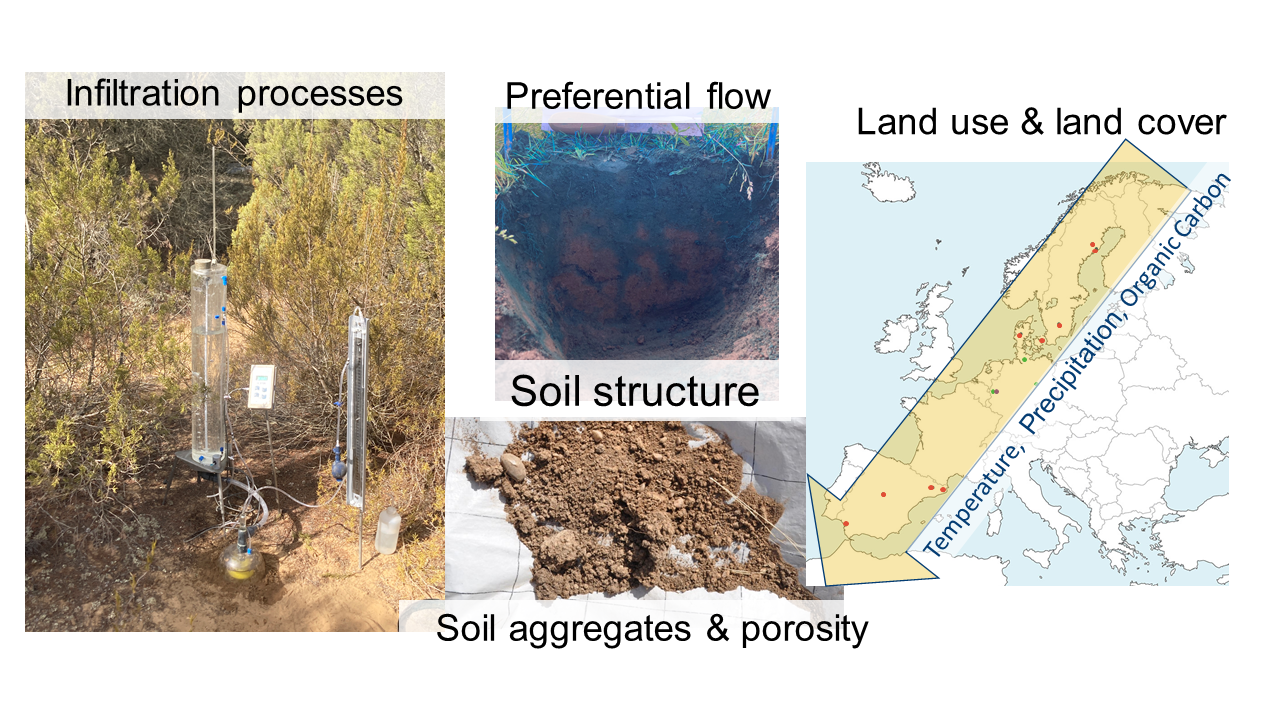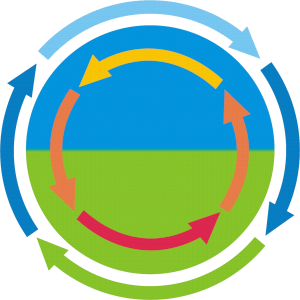A01
Structural controls of soil hydraulic properties
Dr. Sara Bauke
University of Bonn | +49-228-73 2965 |
Prof. Dr. Wulf Amelung
University of Bonn | +49-228-73 2780 |
Summary
The hydraulic conductivity function of soils is a key property, controlling the partitioning of water into soil infiltration and surface runoff as well as the flow of water within the soil profile. Structure is an important factor for hydraulic conductivity in the wet range of soil moisture. However, this is currently not well implemented into land surface models, which typically produces incorrect representations of hydraulic conductivity at and near saturation, erroneous estimates of water partitioning at the soil surface especially in extreme events and thereby a misrepresentation of soil and surface water fluxes in the global water cycle. In this project we therefore assess the effect of soil structure on soil hydraulic conductivity for different climatic, soil and land use settings across Europe. The results are then incorporated into continental-scale modelling of water and energy cycles.
Graphical Summary

Contribution to CRC
Project A01 contributes to the overall goals of the CRC by recalibrating infiltration and soil hydraulic conductivity as a function of soil structure. These represent crucial processes in the global water cycle that respond to land use and land cover change. Analyses in project A01 are conducted along a European climate transect, which is also used in project C03, using partly the same soil samples for the analysis of the basic soil properties (texture, bulk density, pH, carbon, nitrogen, and sulphur content). There will also be close collaboration within cluster A, with projects A02 and A03, which will partially work at the same sites. This will allow for joint analyses of structure-mediated infiltration processes on soil water storage and availability of water for evapotranspiration as well as linking soil structure, infiltration and water storage to the global carbon cycle. Finally, the data and results from project A01 will be included in the modelling efforts that are conducted by cluster D with the help of cluster Z.
Approach
We assume that soil structure is largely influenced by land use and land cover and therefore, compare three different land uses (cropland, forests, and grasslands) along a climate transect across Europe. At those locations, the near saturated hydraulic conductivity was measured using a hood infiltrometer and soil samples were taken to assess soil structure by combining laboratory analyses such as aggregate fractionation and soil water retention characteristics with scanning methods (e.g. XrayCT) and image analysis of dye tracer experiments in the field. After that, a dataset will be created based on the previously stated experiments that can be used to deliver a model that represents the effects of soil structure on hydraulic conductivity across the climate transect.
Main Results in 2022
- Conducted sampling and measuring campaign of 9 out of 12 sites on the European transect
- Started processing the samples
- Publication: Soil hydrology in the Earth system. Vereecken, H.; Amelung, W.; Bauke, S. L.; Bogena, H.; Brüggemann, N.; Montzka, C.; Vanderborght, J.; Bechtold, M.; Blöschl, G.; Carminati, A.; Javaux, M.; Konings, A. G.; Kusche, J.; Neuweiler, I.; Or, D.; Steele-Dunne, S.; Verhoef, A.; Young, M.; and Zhang, Y. Nature Reviews Earth & Environment, 3(9): 573–587. August 2022.
- Publication: Soil water status shapes nutrient cycling in agroecosystems from micrometer to landscape scales. Bauke, S. L.; Amelung, W.; Bol, R.; Brandt, L.; Brüggemann, N.; Kandeler, E.; Meyer, N.; Or, D.; Schnepf, A.; Schloter, M.; Schulz, S.; Siebers, N.; Von Sperber, C.; and Vereecken, H. Journal of Plant Nutrition and Soil Science, 185(6): 773–792. December 2022.
Main Results in 2023
- Finished laboratory analysis of basic soil properties (pH, bulk density, carbon content, texture) of 9 out of 12 sites.
- Finished Analysis of soil aggregates of 9 out of 12 sites
- Conducted sampling and measuring campaign of all sites on the European transect
- Conducted sampling and measuring campaign on the texture gradient on cropland near Cologne
- Processing of infiltration data and calculation of saturated hydraulic conductivity for all sites
- Master thesis: “Land use-dependent soil aggregation affects infiltration rates in Europe”
- Master thesis: “Analysis the impact of land use on soil hydraulic characteristics”
- Presentation at the congress of the German Soil Science Society (DBG) “Connecting near saturated hydraulic conductivity to soil aggregation under different land uses”
Main Results in 2024
- Finished laboratory analysis for all samples (soil aggregation, hydrophobicity, saturated hydraulic conductivity, water retention curves)
- Finished image analysis of all preferential flow images
- Conducted sampling and measuring campaign to estimate the effect of soil management and temporal/seasonal variation of soil structure.
- Poster at the general assembly of the European Geosciences Union (EGU) “Connecting soil structure and hydraulic properties under different land use on a European climate gradient”
- Outreach activities such as girl’s day
Main Results in 2025
- Presentation at the general assembly of the European Geosciences Union (EGU): ”Connecting (near) saturated hydraulic conductivity to soil aggregation and carbon content on croplands across Europe”
- Outreach activities such as Girl’s Day, Tag der Offenen Tür (Open day)
- Publication: Burger, D. J. (2025). Ecosystem Restoration Should Rely on Self‐Repairing Mechanisms. Global Change Biology, 31(7), e70357.
- Upcoming presentation at the congress of the German Soil Science Society (DBG) “Connecting (near) saturated hydraulic conductivity to soil aggregation and carbon content on croplands across Europe”

